Our hostesses this month, Evelyne of Cheap Ethnic Eatz, and Valerie of a The Chocolate Bunny, chose delicious pate with freshly baked bread as their June Daring Cook’s challenge! They’ve provided us with 4 different pate recipes to choose from and are allowing us to go wild with our homemade bread choice.
——————————————————-
YES that is me! What an honor it was to co-host this challenge with my wonderful partner Valérie. I had so much fun creating this challenge. It was hard picking our recipes and we emailed each other frantically. Being both in the same city really helped too. We even met up for a test tasting lol. Thank you to everyone who participated and congratulations on all your amazing creations. Check out here what everyone else made.
We brainstormed for a while before agreeing on what to throw at you guys. We wanted something suitable for June – so nothing too heavy, or too heat-intensive (for the Northern Hemisphere at least). In the end, we decided that this month’s challenge would be: pâté. It’s incredibly versatile, it has the potential to be beautifully presented, and it’s perfect for summer (think picnics in the park).
Now, we (well, one of us, at least, can you guess which?) had a bit of an existential crisis about what does and does not constitute a pâté. And we’re actually still not sure. Because, while looking through recipes and cookbooks, we also came across the term “terrine” quite a lot, and in a lot of cases, the two words appeared to be interchangeable. Technically, a terrine is a baking recipient, usually ceramic or porcelain, with a lid – but it can also refer to the contents of the recipient. And some of the pâtés we looked at were designed to be unmolded onto a dish and then sliced, while others were meant to be left in the jar or baking dish they were prepared in, and merely used as a spread. It also didn’t help that both of us, being bilingual, looked at recipes in French and English, and that the actual definitions might differ from one language to another!
Traditionally, pâté is meat-based, and often includes liver, or gizzards, or other potentially icky animal parts. But, because we realize that not everyone likes that kind of pâté, we have also included recipes for fish pâté, and vegetable pâté. However, if you know that you enjoy liver pâté, but are a little squeamish about cooking with liver, we urge you to give it a try: after making these, neither of us will ever buy meat-based pâté ever again! Having said that, the meatless pâtés are also very tasty.
Now, since pâté is rarely eaten alone, we are adding a second part to this challenge: you will have to make a bread, to go with your pâté. We’ve included a really good recipe for French baguette. However, because baguette is quite time-consuming to make, and because we know that the Daring Bakers have already made baguette a while ago, we’re also giving you a quicker recipe for a sandwich loaf, which you can also choose to make as little rolls, with white or whole wheat flour. But really, we’re giving you free range for the bread part of the challenge: if there’s a daring bread recipe you’ve been dying to try, and you think it would go well with your pâté, go for it!
Recipe Sources:
– Three Spice Liver Pâté: adapted from Ravenous Couple, which was inspired by White on Rice Couple.
– Chicken Liver Pâté: slightly adapted from Stéphane Reynaud’s Terrine
– Tricolor Vegetable Pâté: from Bon Appétit Oct 1993 on Epicurious
– Trout and Shrimp Pâté: unknown (handed down to Valerie from someone, who got it from someone else, etc.)
– French Baguette: from King Arthur Flour
– Sandwich Loaf: translated from Josée Fiset and Éric Blais’s Pain (“pain” means “bread” in French – no physical suffering involved here!)
Notes:
– For all pâtés: We have each worked with various sizes and shapes of baking pans. We have indicated the size of the pans we used, but feel free to adapt the quantities to the bake ware you have on hand.
– After bakingthe Three Spice Liver Pâté, Chicken Liver Pâté and the Trout and Shrimp Pâté, when taken out of the oven they had all shrunk slightly, and they were swimming in liquid fat. The longer you allow the pâtés to cool, the more the juices will get soaked in the pâté. When removing from the mold, drain the excess fat. You can also drain some of the fat before unmolding, but keeping mind your pâté may be a littler drier.
– Chicken Liver Pâté and Trout Pâté: These recipes involve flambéing ingredients with alcohol. This actually adds a lot of flavor to the dish. However, if you do not wish to consume alcohol, or if you are uncomfortable with flambéing, you can omit this step. IMPORTANT PRECAUTION: When flambéing, make sure to always keep an airtight lid within your reach, in case you need to put out the flames quickly.
– Tricolor Vegetable Pâté: Refrigerate as long as possible, min 8 hours. Freeze it 30 min before unmolding.
– French Baguette: Use the lesser amount of water in summer (or in a humid environment), the greater amount in winter (or in a dry climate), and somewhere in between the rest of the year, or if your house is climate controlled. Spritz the baguettes heavily with warm water; this will help them develop a crackly-crisp crust.
– Sandwich Loaf: We only made the whole wheat version of this bread, and the little rolls where tested, rather than two large loaves. However, they were perhaps a little heavy. If you want to make the whole wheat version, but prefer soft, light bread, you may want to use half white flour and half whole wheat (or use a two-to-one ratio, it’s really your choice). You can also halve the recipe and just make one loaf.
– What to serve your pâtés with, besides the bread? How about some pickles, cheeses, grapes, or an onion confit. Let your imaginations go wild!
Mandatory:
Your pâté has to 1) be baked or refrigerated (or both) for a significant amount of time, so that 2) you have to be able to unmold it onto a serving dish. This is to avoid the possibility of someone puréeing a bunch of vegetables, putting the mixture in a jar, and calling it “vegetable pâté”: that is not a pâté, that is a spread.
Preparation time:
Tricolor Vegetable Pâté: 35 minutes preparation, 8+ hours refrigerating
Three Spice Liver Pâté: 40 minutes preparation, 1 to 1.5 hours cooking
Trout and Shrimp Pâté: 20 minutes preparation, 35 minutes cooking, 30-60 minutes cooling
Chicken Liver Pâté: 40 minutes preparation, 2.5 hours cooking, at least 1 hour of refrigeration
French Baguette: 40 minutes preparation, 19 hours resting, 30 minutes cooking
Sandwich Loaf: 30 minutes preparation, 3 hours resting, 40 minutes cooking (25 if making rolls)
Recipes:
Three Spice Liver Pâté
Yields one 25 by 12,5 cm (10 by 5 inch) terrine or loaf pan
1 lb / 454 grams pork liver (or beef or combination)
1/2 lb / 227 grams ground pork
1/2 lb / 227 grams pork fat (or pork belly)
2 cloves garlic
2 shallots
1 whole egg and 1 egg yolk
1/2 tsp / 2 ml cinnamon
1/2 tsp / 2 ml coriander (ground or crushed)
1/2 tsp / 2 ml cumin
3/4 tsp / 3 ml salt
1 tbsp / 15 ml coarse freshly cracked peppercorns
2 tbsp / 30 ml cognac
2 bay leaves
1 package of bacon
Preheat oven to to 350ºF (180ºC).
Cut liver and pork fat into small pieces and add to food processor. Add ground pork, garlic, shallots, cinnamon, cumin, coriander, salt and pepper. Grind until smooth.
In mixing bowl, incorporate the meat and liver mixture with the cognac and eggs.
Line bottom of baking or ceramic pan with overlapping pieces of bacon. Place a bay leaf on the bottom and then fill with meat/liver mixture. Cover top with another bay leaf and then overlapping pieces of bacon.
Place in oven in the larger baking pan and add enough water to cover 2/3rds of the pan containing the meat/liver mixture. Bake for about 1-1.5 hrs.
The pâté will contract and the juices will be on the bottom. Allow to cool and soak up the juices. Remove any excess bacon and discard the bay leaves.
Chicken Liver Terrine
Yields one 25 by 12,5 cm (10 by 5 inch) terrine or loaf pan
1 tbsp duck fat, or butter
2 onions, coarsely chopped
300g (11 oz) chicken livers, trimmed
3 tbsp brandy, or any other liqueur (optional)
100g (3 1/2 oz, 1/2 cup) smoked bacon, diced
300g (11 oz) boneless pork belly, coarsely ground
200g (7 oz) boneless pork blade (shoulder), coarsely ground (or ground pork see note below)
2 shallots, chopped
1 tsp quatre-épices (or 1/4tsp each of ground pepper, cloves, nutmeg and ginger is close enough)
2 eggs
200 ml (7 fl oz, 3/4 cup + 2 tbsp) heavy cream
2 fresh thyme sprigs, chopped
Salt and pepper
NOTE: If you cannot find ground pork belly or blade, buy it whole, cut it into chunks, and pulse in the food processor. You can also replace the pork blade with regular ground pork.
Preheat oven to 200ºC (400ºF, Gas Mark 6).
Melt the fat or butter in a heavy frying pan over low heat. Add the onions and cook, stirring occasionally, for 5 minutes, until softened. Add the chicken livers and cook, stirring frequently, for about 5 minutes, until browned but still slightly pink on the inside.
Remove the pan from heat. Pour in the brandy, light a match and carefully ignite the alcohol to flambé. Wait for the flames to go out on their own, carefully tilting the pan to ensure even flavoring. Set aside.
Put the minced pork belly and blade in a food processor, then add the onion-liver mixture and the chopped shallots, and pulse until you obtain a homogenous mixture – make sure not to reduce it to a slurry.
Transfer to a bowl, and gradually stir in the chopped bacon, quatre-épices, cream, eggs, and thyme. Season with salt and pepper, and mix well. Spoon the mixture into a terrine or loaf pan, and cover with the terrine lid or with aluminum foil.
Prepare a water bath: place the loaf pan in a larger, deep ovenproof dish (such as a brownie pan or a baking dish). Bring some water to a simmer and carefully pour it in the larger dish. The water should reach approximately halfway up the loaf pan.
Put the water bath and the loaf pan in the oven, and bake for 2 hours. Uncover and bake for another 30 minutes. The terrine should be cooked through, and you should be able to slice into it with a knife and leave a mark, but it shouldn’t be too dry. Refrigerate, as this pâté needs to be served cold. Unmold onto a serving platter, cut into slices, and serve with bread.
NOTE: This pâté freezes well. Divide it into manageable portions, wrap tightly in plastic film, put in a freezer Ziploc bag, and freeze. Defrost overnight in the fridge before eating.
Tricolor Vegetable Pâté
Yields one 25 by 12,5 cm (10 by 5 inch) terrine or loaf pan
Line your pan with plastic wrap, overlapping sides.
White Bean Layer
2 x 15-ounce / 900 ml cans cannellini (white kidney beans), rinsed, drained thoroughly
1 tbsp / 15 ml fresh lemon juice
1 tbsp / 15 ml olive oil
1 tbsp / 15 ml minced fresh oregano or 1 teaspoon dried
2 garlic cloves, pressed
Mash beans in large bowl. Add lemon juice, olive oil, oregano and garlic and blend until smooth. Season to taste with salt and pepper. Spread bean mixture evenly on bottom of prepared pan.
Red Pepper Layer
7-ounce / 210 ml jar roasted red bell peppers, drained, chopped
3/4 cup / 180 ml crumbled feta cheese (about 4 ounces)
Combine peppers and feta in processor and blend until smooth. Spread pepper mixture evenly over bean layer in prepared dish.
Pesto Layer
2 garlic cloves
1 cup / 240 ml fresh basil leaves
1 cup / 240 ml fresh Italian parsley leaves
1/4 cup / 60 ml toasted pine nuts
3 tbsp / 45 ml olive oil
1/2 cup / 120 ml low-fat ricotta cheese
Mince garlic in processor. Add basil, parsley and pine nuts and mince. With machine running, gradually add oil through feed tube and process until smooth. Mix in ricotta. Spread pesto evenly over red pepper layer.
Cover with plastic wrap and refrigerate overnight.
To unmold, invert pâté onto serving platter. Peel off plastic wrap from pâté. Garnish with herb sprigs and serve with sourdough bread slices.
Trout and Shrimp Pâté
Yields one 6×3 inch (15×7,5 cm) terrine or loaf pan
1 tbsp / 15 ml butter
1/4 lb / 4 oz / 120g medium raw shrimp, deveined, shelled and tailed (about 12 medium shrimp)
1/8 cup / 30ml Grand Marnier (or cognac, or another strong liqueur of your choice) (optional)
1/2 lb / 8 oz / 240g trout filet, skinned and cut into thick chunks
1/4 lb / 4 oz / 110g raw shrimp, deveined, shelled and tailed (any size)
3/4 cup / 180ml heavy cream
Salt, to taste
Green peppercorn, coarsely ground, to taste
Chives, for garnish
Preheat oven to 375ºF (190ºC).
In a heavy, flameproof frying pan, melt the butter over medium-high heat. Sauté the 1/4 pound of medium shrimp, stirring often, until pink and cooked through. Remove the pan from heat. (NOTE: These shrimp will be used to form layers within your pâté. If you feel they are too thick – like the ones in the photograph, you might want to slice them in half lengthwise.)
Pour the Grand Marnier over the cooked shrimp. Light a match and carefully ignite the alcohol, to flambé the shrimp. Wait for the flames to go out on their own, carefully tilting the pan to ensure even flavoring. Set aside.
Put the trout and the remaining raw shrimp in a food processor and pulse. Gradually pour in the cream and keep pulsing until you obtain a smooth mixture that is easy to spread, but not too liquid (you may not need to use all the cream). Season with salt and green pepper.
Butter a 6×3 inch (15×7,5 cm) loaf pan or terrine, then line it with parchment paper. Spoon in half the trout mixture, and spread it evenly. Place the flambéed shrimp on top, in an even layer, reserving 3 or 4 shrimp for decorating. Top with the remaining trout mixture.
Prepare a water bath: place the loaf pan in a larger, deep ovenproof dish (such as a brownie pan or a baking dish). Bring some water to a simmer and carefully pour it in the larger dish. The water should reach approximately halfway up the loaf pan.
Put the water bath and terrine in the oven, and bake for 35 minutes. The pâté should be cooked through and firm in the center.
Remove the pan from the water bath and let cool. Carefully unmold onto a serving platter. Decorate with the reserved shrimp, and sprinkle with chopped chives. Cut into thick slices and serve at room temperature, with crusty bread.
French Baguette
yield: Three 16″ baguettes
Starter
1/2 cup / 120 ml cool water
1/16 teaspoon active dry yeast
1 cup / 240 ml flour
Dough
1 tsp / 5 ml active dry yeast
1 cup to 1 1/4 cups / 240 ml to 300 ml lukewarm water*
all of the starter
3 1/2 cups / 840 ml flour
1 1/2 tsp / 7 ml salt
*Use the lesser amount in summer (or in a humid environment), the greater amount in winter (or in a dry climate), and somewhere in between the rest of the year, or if your house is climate controlled.
Make the starter by mixing the yeast with the water, then mixing in the flour to make a soft dough. Cover and let rest at room temperature for about 14 hours; overnight works well. The starter should have risen and become bubbly.
Mix active dry yeast with the water and then combine with the starter, flour, and salt. Mix and knead everything together—by hand, mixer or bread machine set on the dough cycle—till you’ve made a soft, somewhat smooth dough; it should be cohesive, but the surface may still be a bit rough. Knead for about 5 minutes on speed 2 of a stand mixer.
Place the dough in a lightly greased medium-size bowl, cover the bowl, and let the dough rise for 3 hours, gently deflating it and turning it over after 1 hour, and then again after 2 hours.
Turn the dough out onto a lightly greased work surface. Divide it into three equal pieces. Shape each piece into a rough, slightly flattened oval, cover with greased plastic wrap, and let them rest for 15 minutes.
Working with one piece of dough at a time, fold the dough in half lengthwise, and seal the edges with the heel of your hand. Flatten it slightly, and fold and seal again. With the seam-side down, cup your fingers and gently roll the dough into a 15″ log. Place the logs seam-side down onto a lightly greased or parchment-lined sheet pan or pans.
Cover them with a cover or lightly greased plastic wrap, and allow the loaves to rise till they’ve become very puffy, about 1 1/2 hours. Towards the end of the rising time, preheat your oven to 450ºF (240ºC).
Using a very sharp knife held at about a 45° angle, make three 8″ vertical slashes in each baguette. Spritz the baguettes heavily with warm water; this will help them develop a crackly-crisp crust.
Bake the baguettes until they’re a very deep golden brown, 25 to 30 minutes. Remove them from the oven and cool on a rack. Or, for the very crispiest baguettes, turn off the oven, crack it open about 2″, and allow the baguettes to cool in the oven.
Sandwich Loaf
Yields two 8 1/2 x 4 1/2 x 2 1/2 inch (21 x 12 x 6 cm) loaves, or 18 individual rolls
For the white version
3 tsp (15 ml) active dry yeast
2 2/3 cups (600 ml) whole milk (3.25 per cent fat), warmed to a temperature of 97ºF (36ºF)
2 1/2 tsp (12.5 ml) salt
2 tsp (10 ml) butter, melted
5 1/3 cups (750g) unbleached white bread flour, + 1/2 cup (75g), for working the dough
2 tbsp (30 ml) butter, for the loaf pan
For the whole wheat version
Use the same amount of whole wheat flour, and add 1/3 cup (80 ml) of milk
To make loaves
In a large mixing bowl, combine the yeast and warm milk, and whisk to dissolve. Whisk in the salt and the melted butter.
Gradually sprinkle in the flour, stirring with a wooden spoon. When the dough becomes too thick to stir, knead it with your hands, for about 5 minutes, until you obtain a smooth, homogenous dough that is soft and a little sticky. Cover with plastic wrap and let rest 30 minutes.
Knead the dough 20 strokes (still in the bowl), cover again, and let rest for 1.5 hour.
Transfer the dough to a lightly floured work surface, and divide in two. Form each half into a slightly oval ball. Butter your two loaf pans and transfer the dough to the pans. Cover lightly and let rise in a draft-free area for 60 minutes, or until doubled in volume.
Fill a large baking pan with hot water (simmering is fine) and place in the oven. Preheat oven to 450ºF (240ºC).
Put the loaves in then oven and bake for 10 minutes. Do not open the oven door during this time. After 10 minutes, lower the oven temperature to 400ºF (200ºC) and continue baking for about 25 minutes, or until the loaves are nicely golden. Unmold and let cool on a rack.
To make individual rolls
Go through the same process as for making the loaves, up until it is time to shape the loaves. Divide the dough into 18 sections, shape each section into a ball, and dust with flour. Butter part of two muffin tins (only butter 18 cavities), and transfer the balls of dough into the cavities.
Cover loosely and let rise in a draft-free area for 45 minutes.
Fill a large baking pan with hot water (simmering is fine) and place in the oven. Preheat oven to 425ºF (225ºC).
Put the loaves in then oven and bake for about 25 minutes, or until the rolls are nicely golden. Let cool on a rack.
Additional Information:
Recipes:
Vegan Nutty pâté
Vegan Mushroom Pâté
Gluten-free French Baguettes
Videos:
Liver pâté preparation
Shaping the French Baguette
Art and History of the French Baguette
Bread Rolls

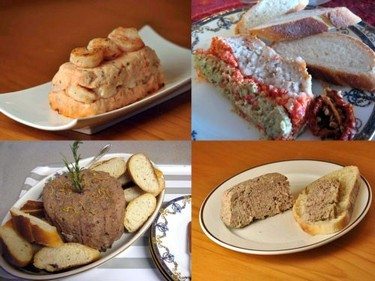
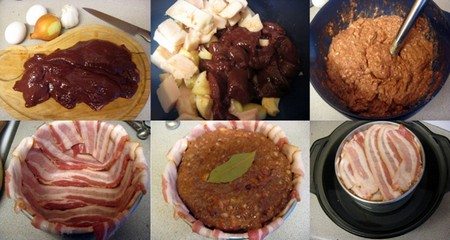
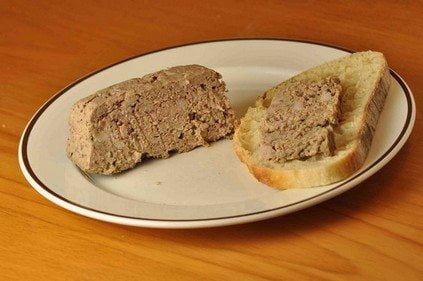

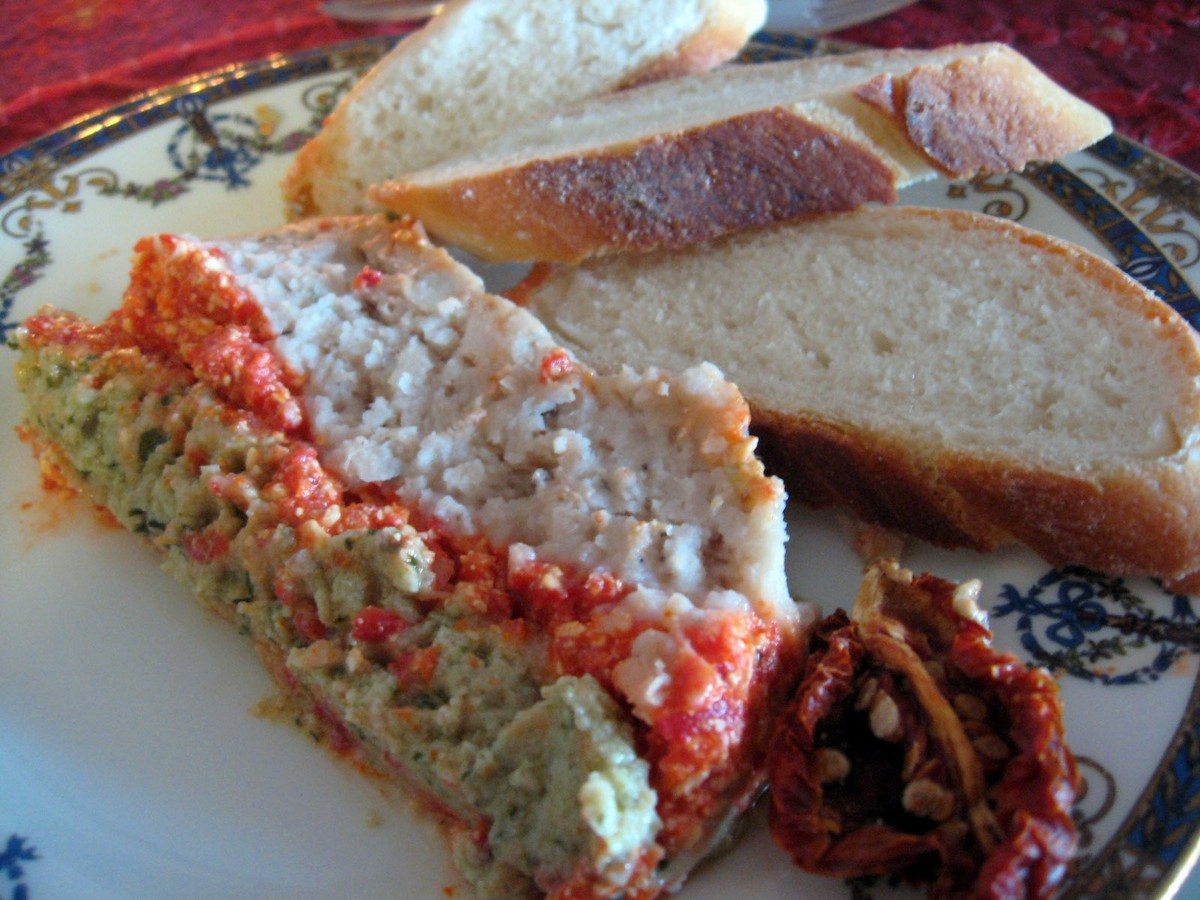


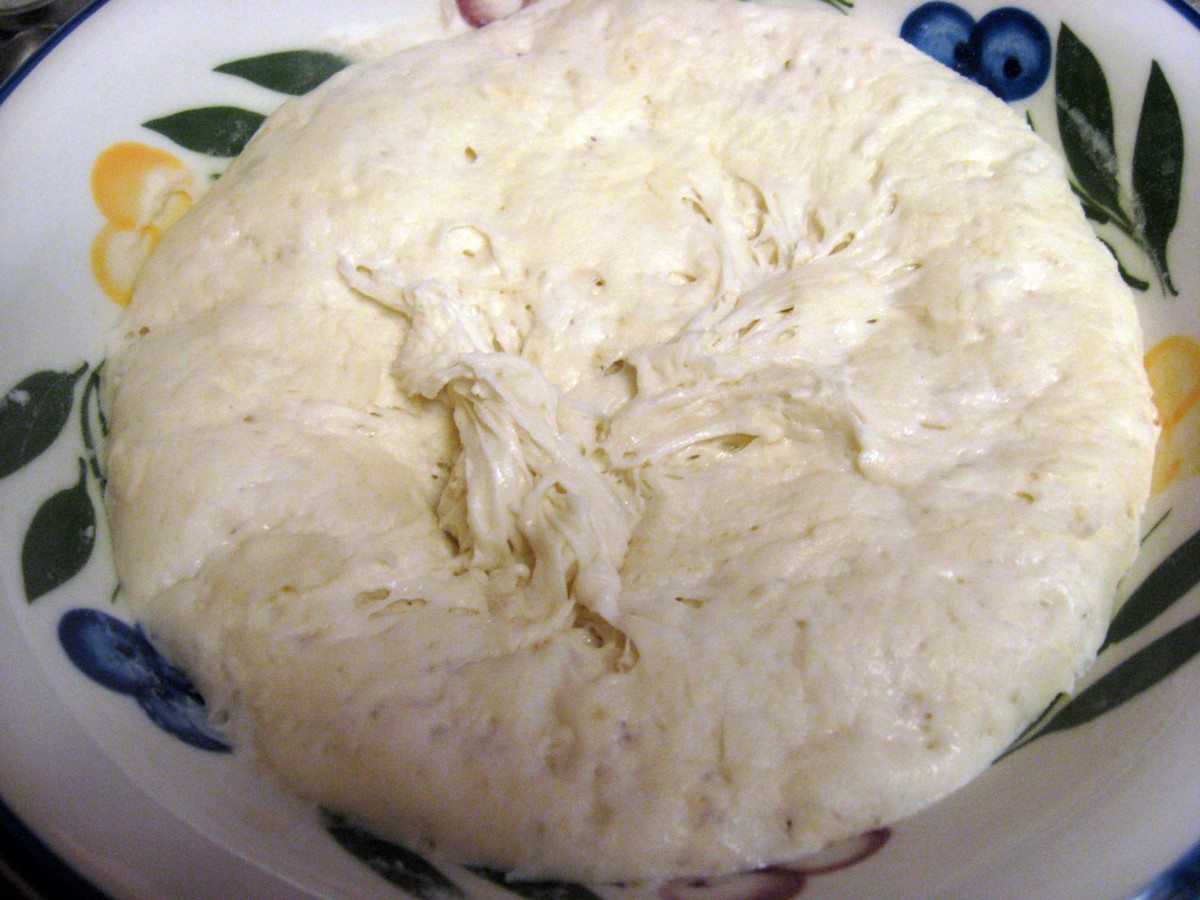
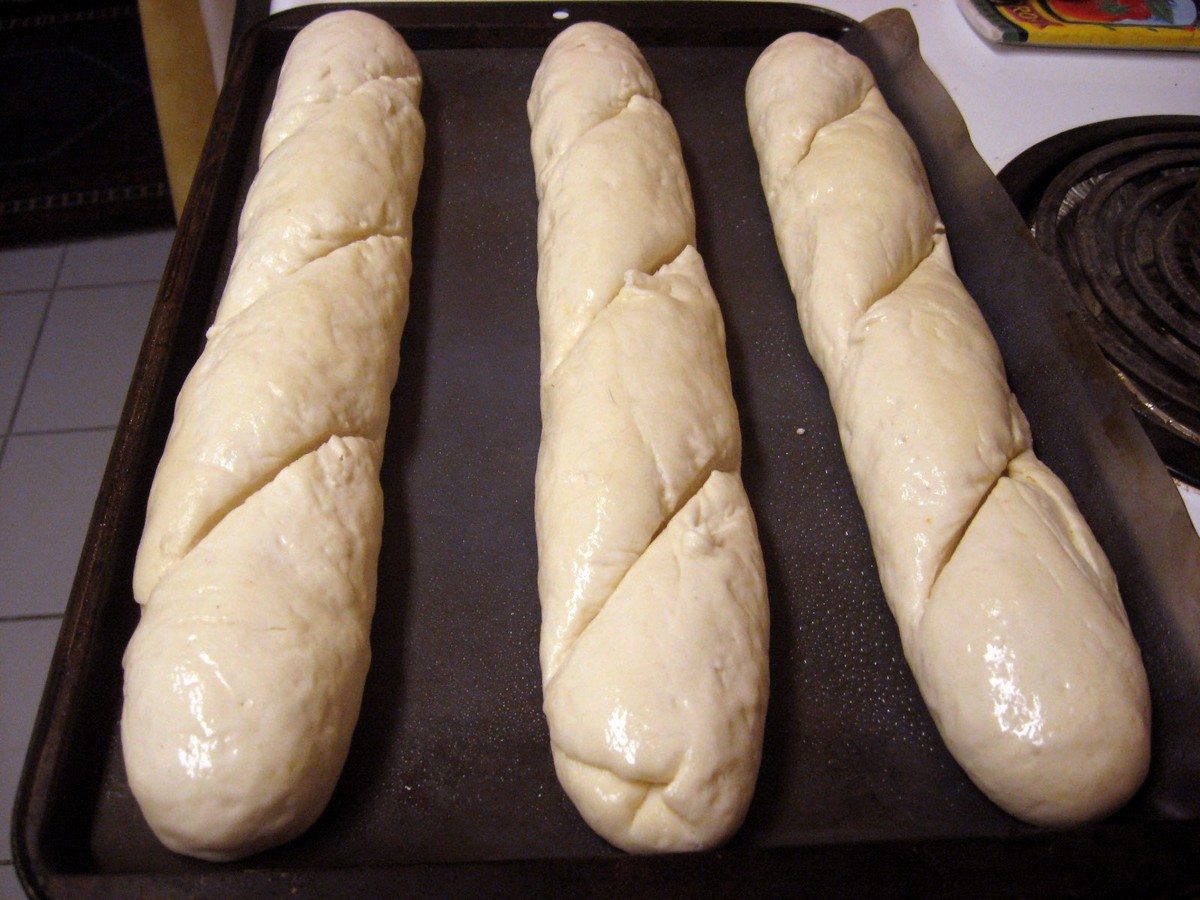
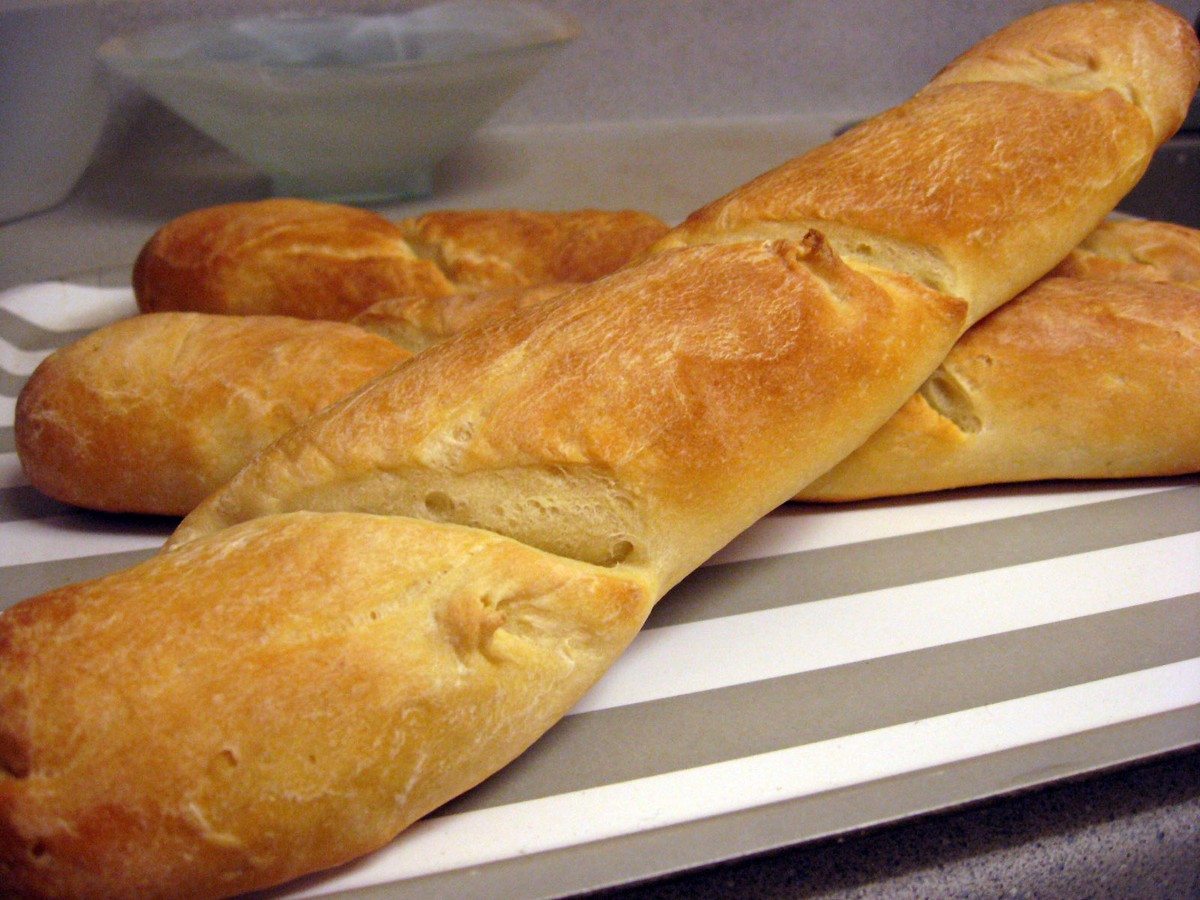




Ev..thank you so much for a wonderful challenge! Everyone LOVED the veggie pate. Your pates and breads turned out so lovely, and as Im mentioned to Valerie..I’m looking forward to trying the seafood pate.
On another note..I love that my cannoli challenge had a little to do with you and Claudia meeting and establishing a friendship 😀
That shrimp and trout pate is stunning. What a great challenge you two came up with. Thank you both for all the hard work.
I’m so impressed with this challenge that you and Valerie worked so hard to put together. I’m sure many would have never attempted to make pates if it hadn’t been put forth to them in a challenge. I wish I could have made all of them, but we are only two people in my house, so we never would have been able to eat all of them. As a yeast bread lover, the French bread was awesome.
Thank you again for the challenge, Evelyne! It wasn’t easy, but it was so satisfying at the end to know that I’d done it. 🙂
I have to admit this was a very special challenge for me. I just love offal and to make offal pâté is even better! I just adored this challenge and I made a number of different pâtés of it. Wonderful challenge and a big thank you for hosting this challenge. Your interpretations are wonderful.
Cheers from Audax from Sydney Australia.
Wow, all three pates look incredible! And sound so perfect with the yummy freshly baked bread!
Thanks for the great challenge Evelyne……really glad that Pate was my first one!
The liver really pushed me out of my comfort zone but it was definitely worth it. The end result was lovely. I’ll have to keep trying with the liver recipes & hopefully de-wuss myself a bit. 😉
Thanks to both of you for all your hard work. It sounded like a lot of effort went into planning the challenge, but it seems to have been a huge success. I only had time to try out one of the recipes but I honestly wish I could have made them all. I shall definitely be having a go in the future. They look delicious.
Thanks again!
Thank you so much for co-hosting this challenge! As someone with a Kosher/vegetarian kitchen, I would never have thought to make pate without you, so thank you! I had a great time, and your hard work was greatly appreciated, as was your support!!
Great challenge, Evelyne! You and Valerie did a great job hosting, and I really enjoyed it. Your pates and breads look amazing!
Thanks again for such an amazing challenge! This was my first challenge and I NEVER would have made pate if not for you and Valerie. I had a great time with this challenge and still would like to make the ones I didn’t get to this month. Great job on hosting and your beautiful pates and bread as well!!
Congrats on a job well done, my friend! It was a lot of fun preparing this challenge with you!
I could not have had a better partner to the you for this! Big hugs
Hey Evelyn, Thanks for choosing such a fun theme this month. I enjoyed making the Pate and bread! 🙂
Wow, thanks so much for hosting this month’s daring cook’s challenge! Sorry I was a wuss and only made the vegetarian pate. It went over really well at a family BBQ! And you inspired me to try my hand at sourdough starter and bread.
Thanks so much for hosting this month! It really was a challenge for me in every sense of the word, and I learned a lot!!!
Thank you so much for hosting a really great challenge. I really appreciate the thought and preparation that went into this challenge, and the versatility of the challenge that you presented to us as Daring Cooks.
Thanks for having us!
Traumatic at first reading (offal…), not so much during the making and very rewarding at the end!
Stay JOLLY!
D
WWWWWWWWWWWOOOOOOOOOOOOOWWWWWWWWWWWW!!!! Can’t believe you and Valerie (and Laurent?) put all this together for the challenge, I’m really impressed!
I never made pate, I am definitely going to try some of them. Thanks for the recipes.
Congratz to both of you!
Thank you Victor….finally the big secret Val and I had has been revealed! Laurent was present in the tasting (which we did after the liquid nitrogen ice cream actually lol) I ha glad we inspired you to try your own paté!
You certainly know how to put a challenge together.
That’s keeping your fellow daring cooks hopping in the kitchen.
I’m extremely impressed with what you and Valerie put together…what a spread!!!
More power to you both ;o)
Flavourful wishes, Claudia
Thank you Claudia.
It was a lot of work but felt more like playing in the kitchen.
Thanks for the challenge Evelyne though you might be putting me in the Daring Cooks’ naughty corner since I was unable to make the bread and I *only* made the vegetarian one. Neil is quite interested in trying out one of the meat pâtés at some point and I have printed them out for him.
Thank you for this challenge! I was interested right away and finished quite early!